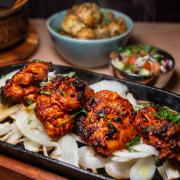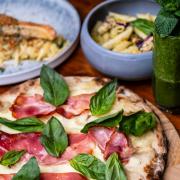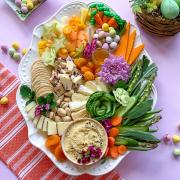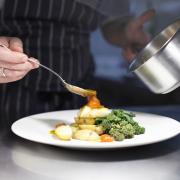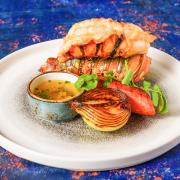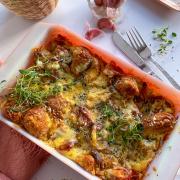Much honoured of late, and even more talked of, the Malaysian restaurant Ning in Manchester’s Northern Quarter is to be the venue for my first cookery class. Though there’s no logic to the thought, its location next to a comedy club gives rise to the hope this will not be a ‘Yes chef, no chef’ experience with a screaming egomaniac in a toque.

My seven fellow foodies – two women five men please note - sip excellent coffee and tea as Ning’s co-owner Andy Spracklen presents his erudite encapsulation of Malaysia’s culinary heritage, knowledge reinforced by a recent tour.

‘Just to give you an idea of how crazy our road-trip was, we covered some 3000 miles in 15 days – we did about a state a day,’ he explains. ‘So we got to experience a huge diversity of foods, but the street food was our particular focus.’ Street food is the subject of our class.

The influence on Malaysian food of Portuguese, Dutch and British rulers and the influxes of Chinese and Indian workers are cited; a tantalising vision of exotic markets and roadside stalls are conjured. Then Andy’s business-partner, chef Norman Musa, joins us - a big smile and warm personality; no toque no screams. ‘It’s all about having fun,’ he says, and means it.

The tone is set for the well-choreographed master-class with a simple demonstration of how to prepare the soul of Malaysian cuisine, lemon grass. Topped and tailed, dry outer-skin removed, moist interior sliced then zapped in a food-processor with a dribble or three of water. Its perfume permeates the room. Layers are added to that fragrance through the day as we toast and grind spices, blend garlic and ginger, chili and coconut milk, tamarind and palm sugar.

‘I learned how to cook as a child helping my mother in the kitchen – my sister preferred to lie on the sofa watching TV!’ He acknowledges that many of his recipes come straight from his mother’s repertoire. ‘She managed to see my cookbook before she passed away,’ he recalls with sadness. And she was proud to see her son cooking for the Lotus F1 team at Grand Prix around the globe.
Over the next four-and-a-half hours Norman, never rushing or cajoling, has us cook five different dishes, his patience equalled by assistants Stephanie, Nazib and Ashley. Not one failure in the end products says more perhaps about the brilliance of the teachers than the pupils, though neither culinary skill nor quiet competitiveness are lacking.
First item on the menu is Chicken Satay, surely the most ubiquitous street snack in Malaysia. We prepare the peanut sauce to accompany the griddled skewers of chicken thigh-meat. ‘I prefer its moistness to breast which can become too dry,’ he tells us. Coated with more lemongrass, spiked with cumin and turmeric, the alchemy of heat and marinade turns pale pink flesh to gold.
Now we make Cucur Udang - prawn fritters: two reasons for nerves – batter and deep frying. But the recipe for batter is surprisingly simple – five dessertspoons of plan flour, one self-raising, a teaspoon each of turmeric and salt, all whisked with water to a thick double-cream consistency that coats beansprouts, Chinese chives and hefty king prawns. ‘I always use them with their tails on – that way they don’t shrink,’ Norman says. ‘And the beansprouts help the crispness – but they must be fresh.’ Our fritters emerge from the vegetable oil (‘Never olive for Malaysian cooking, it just doesn’t taste right,’) superbly crunchy.
We lunch on some of the Satay sticks and fritters – the rest, along with the food cooked afterwards, are packed in foil containers to be borne home in triumph. Those dishes are Kari Laksa Udang, a wet curry of prawns with vermicelli noodles; Apam Balik, sweet pancake filled with peanut and creamed sweetcorn; and the scariest dish of the day: Char Kuey Teow. For this small groups migrate to the kitchen to use the wok-burner. ‘Don’t lean over the wok when you turn the heat high,’ Norman warns, then demonstrates why – think vertical flame-thrower. The amount of garlic included seems equally perilous, but yet again the result is delicious, even if nobody can flip the prawns egg and wide noodles like the professionals.
Before school is out we gather for our certificates and to unwind. Norman compliments our efforts, but it’s clear none of us will rival him anytime soon. Then again, given he just won the title Oriental Chef of the Year, and Ning – named for one of the notes of the Gamelan - was voted Best Malaysian Restaurant, we couldn’t be expected to.
On the train home the aroma of lemon grass, garlic, chili and lime fill the carriage. At home the reheated dishes fill my family.
The Malaysian Street Food Masterclass costs £145. Ning is based at 92 – 94 Oldham Street, Manchester M4 1LJ. 0844 414 5484. www.ningcatering.com




